Airport Planning and Management Report: Canadian Airport
VerifiedAdded on 2022/10/10
|18
|4075
|298
Report
AI Summary
This report offers a comprehensive analysis of airport planning and management, specifically focusing on the context of a small regional airport in Canada. It begins with an executive summary and an introduction that outlines the importance of effective planning. The report then delves into the core components of an airport master plan, including cargo services, airport support facilities, airport utilities, and airport programs. It examines the roles of various airport operators, such as airport authorities, provincial and municipal governments, contracted operators, and private business organizations. The report also covers Canadian aviation rules, airport wildlife management, and safety management systems, including safety policies, risk management, and safety assurance. Finally, it addresses the challenges and provides recommendations for successful airport operation, culminating in a conclusion and references. This report is a valuable resource for students seeking to understand the complexities of airport planning and management.
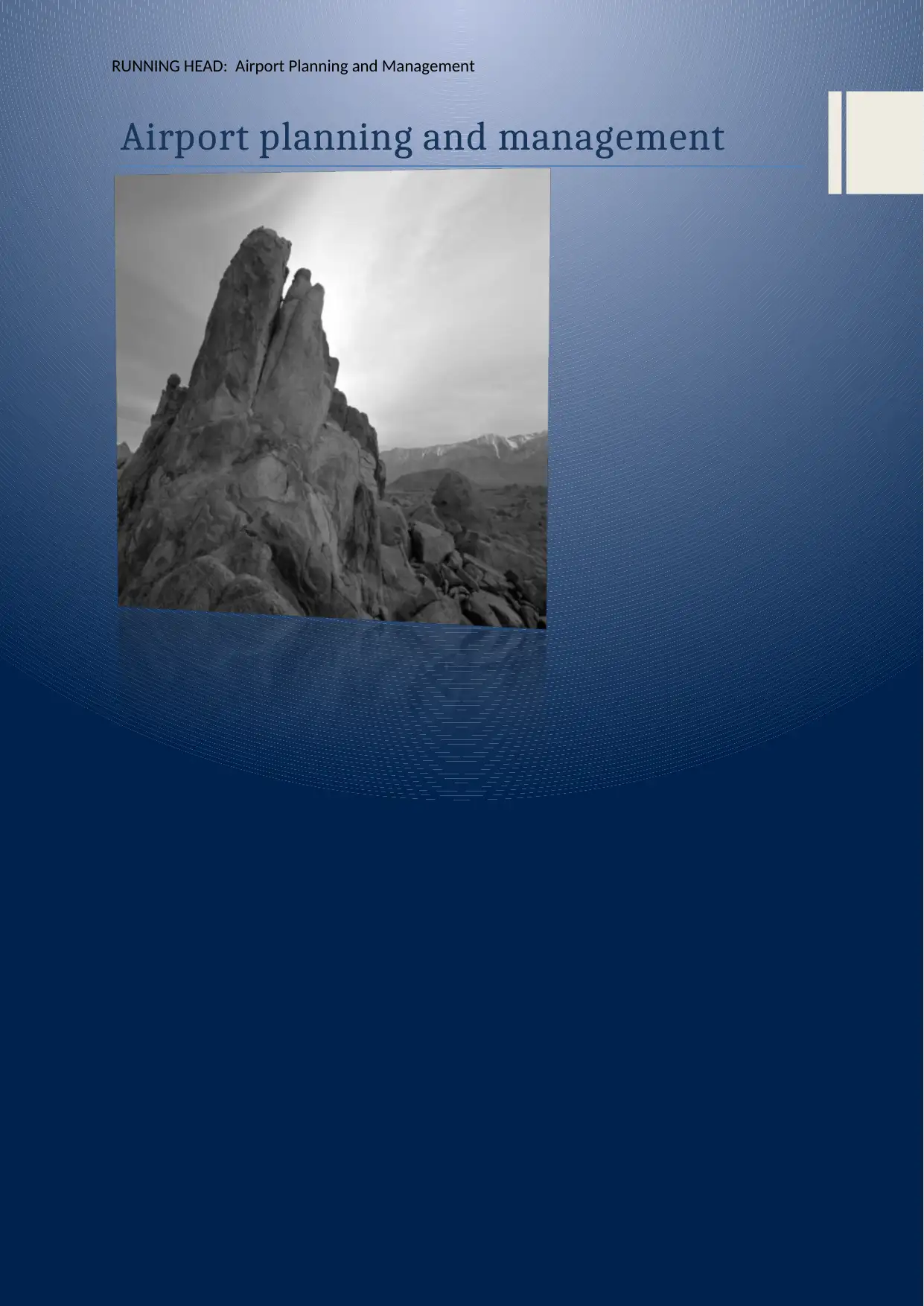
RUNNING HEAD: Airport Planning and Management
Airport planning and management
Airport planning and management
Paraphrase This Document
Need a fresh take? Get an instant paraphrase of this document with our AI Paraphraser
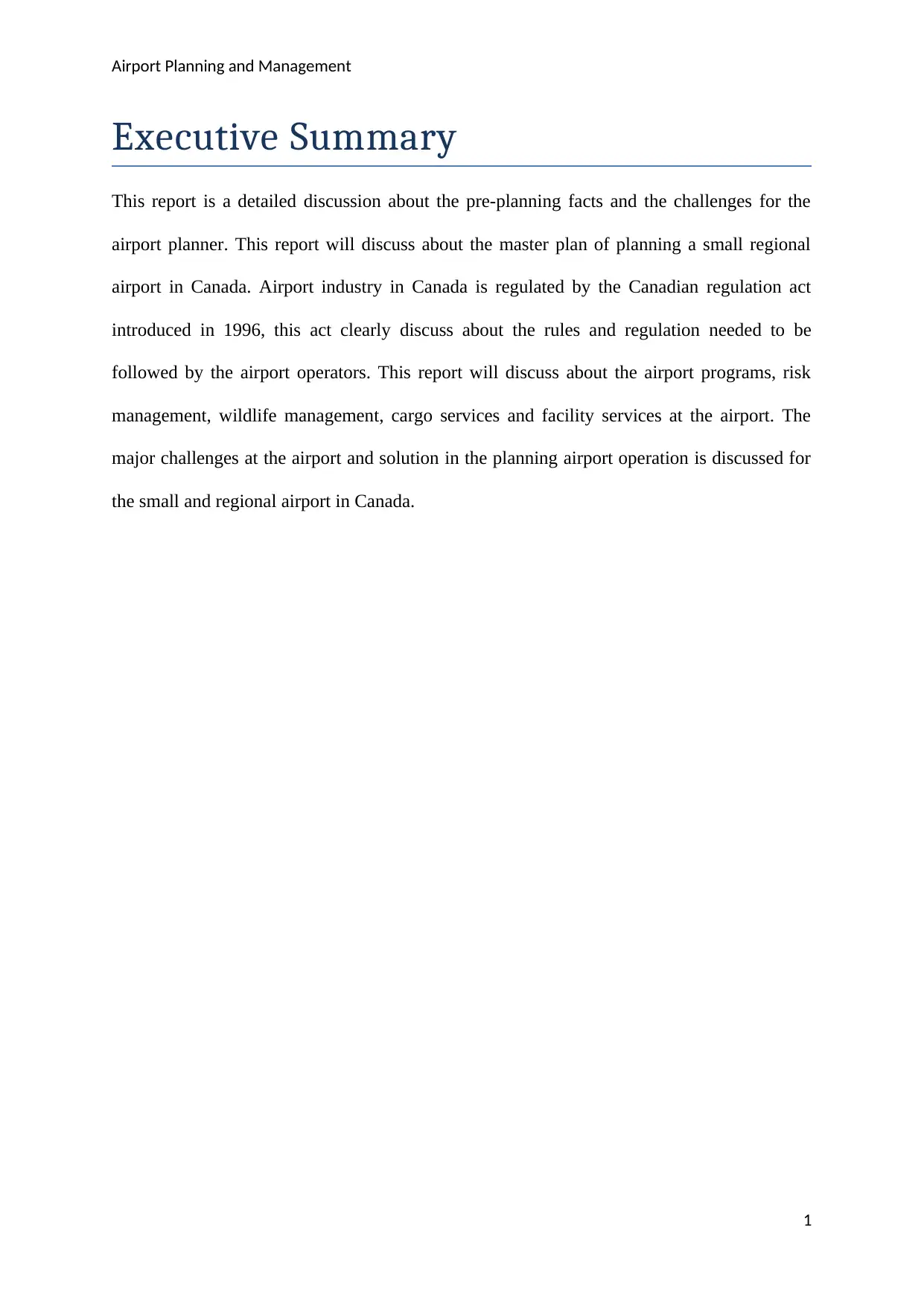
Airport Planning and Management
Executive Summary
This report is a detailed discussion about the pre-planning facts and the challenges for the
airport planner. This report will discuss about the master plan of planning a small regional
airport in Canada. Airport industry in Canada is regulated by the Canadian regulation act
introduced in 1996, this act clearly discuss about the rules and regulation needed to be
followed by the airport operators. This report will discuss about the airport programs, risk
management, wildlife management, cargo services and facility services at the airport. The
major challenges at the airport and solution in the planning airport operation is discussed for
the small and regional airport in Canada.
1
Executive Summary
This report is a detailed discussion about the pre-planning facts and the challenges for the
airport planner. This report will discuss about the master plan of planning a small regional
airport in Canada. Airport industry in Canada is regulated by the Canadian regulation act
introduced in 1996, this act clearly discuss about the rules and regulation needed to be
followed by the airport operators. This report will discuss about the airport programs, risk
management, wildlife management, cargo services and facility services at the airport. The
major challenges at the airport and solution in the planning airport operation is discussed for
the small and regional airport in Canada.
1
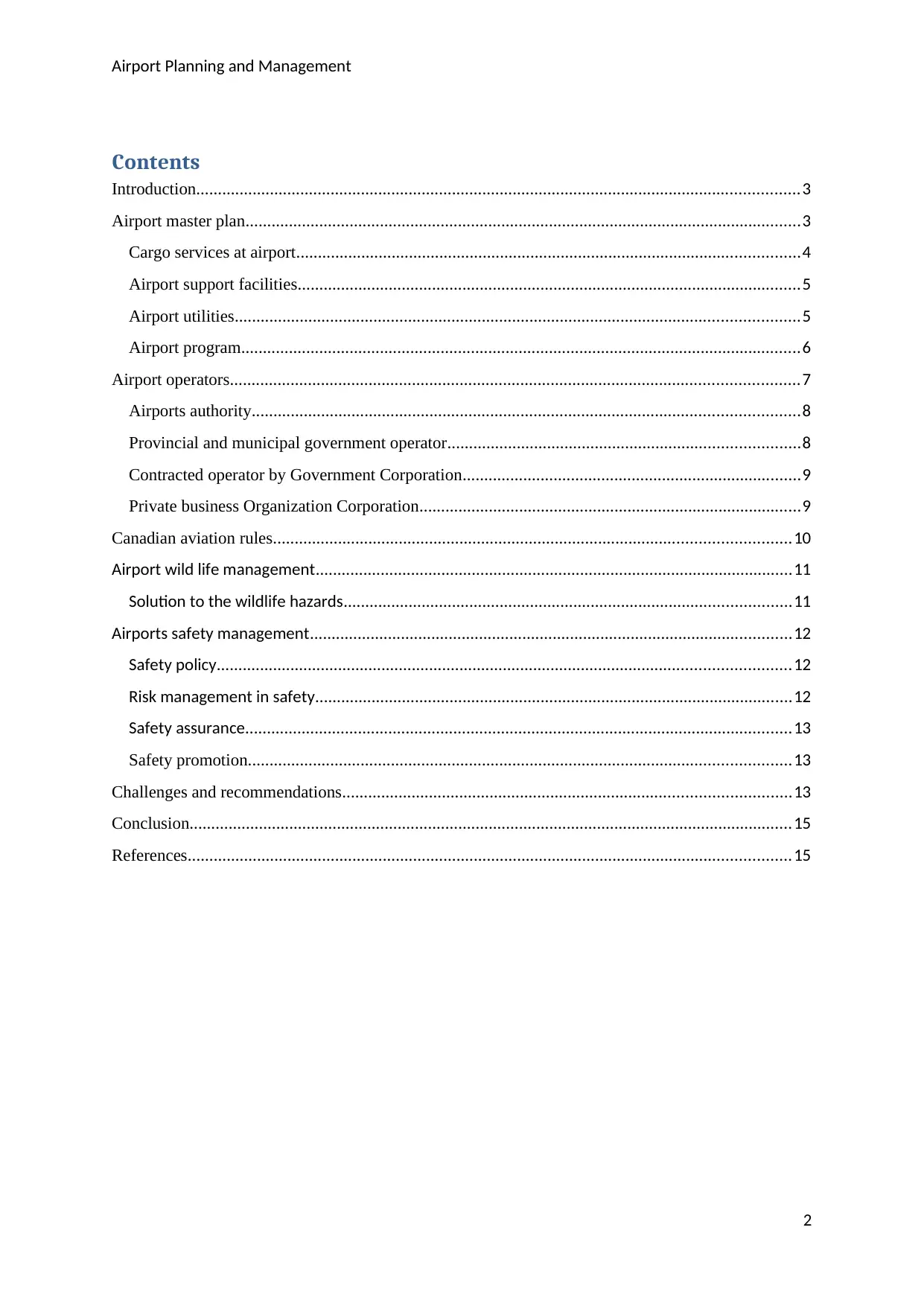
Airport Planning and Management
Contents
Introduction...........................................................................................................................................3
Airport master plan................................................................................................................................3
Cargo services at airport....................................................................................................................4
Airport support facilities....................................................................................................................5
Airport utilities..................................................................................................................................5
Airport program.................................................................................................................................6
Airport operators...................................................................................................................................7
Airports authority..............................................................................................................................8
Provincial and municipal government operator.................................................................................8
Contracted operator by Government Corporation..............................................................................9
Private business Organization Corporation........................................................................................9
Canadian aviation rules.......................................................................................................................10
Airport wild life management..............................................................................................................11
Solution to the wildlife hazards.......................................................................................................11
Airports safety management...............................................................................................................12
Safety policy....................................................................................................................................12
Risk management in safety..............................................................................................................12
Safety assurance..............................................................................................................................13
Safety promotion.............................................................................................................................13
Challenges and recommendations.......................................................................................................13
Conclusion...........................................................................................................................................15
References...........................................................................................................................................15
2
Contents
Introduction...........................................................................................................................................3
Airport master plan................................................................................................................................3
Cargo services at airport....................................................................................................................4
Airport support facilities....................................................................................................................5
Airport utilities..................................................................................................................................5
Airport program.................................................................................................................................6
Airport operators...................................................................................................................................7
Airports authority..............................................................................................................................8
Provincial and municipal government operator.................................................................................8
Contracted operator by Government Corporation..............................................................................9
Private business Organization Corporation........................................................................................9
Canadian aviation rules.......................................................................................................................10
Airport wild life management..............................................................................................................11
Solution to the wildlife hazards.......................................................................................................11
Airports safety management...............................................................................................................12
Safety policy....................................................................................................................................12
Risk management in safety..............................................................................................................12
Safety assurance..............................................................................................................................13
Safety promotion.............................................................................................................................13
Challenges and recommendations.......................................................................................................13
Conclusion...........................................................................................................................................15
References...........................................................................................................................................15
2
⊘ This is a preview!⊘
Do you want full access?
Subscribe today to unlock all pages.

Trusted by 1+ million students worldwide
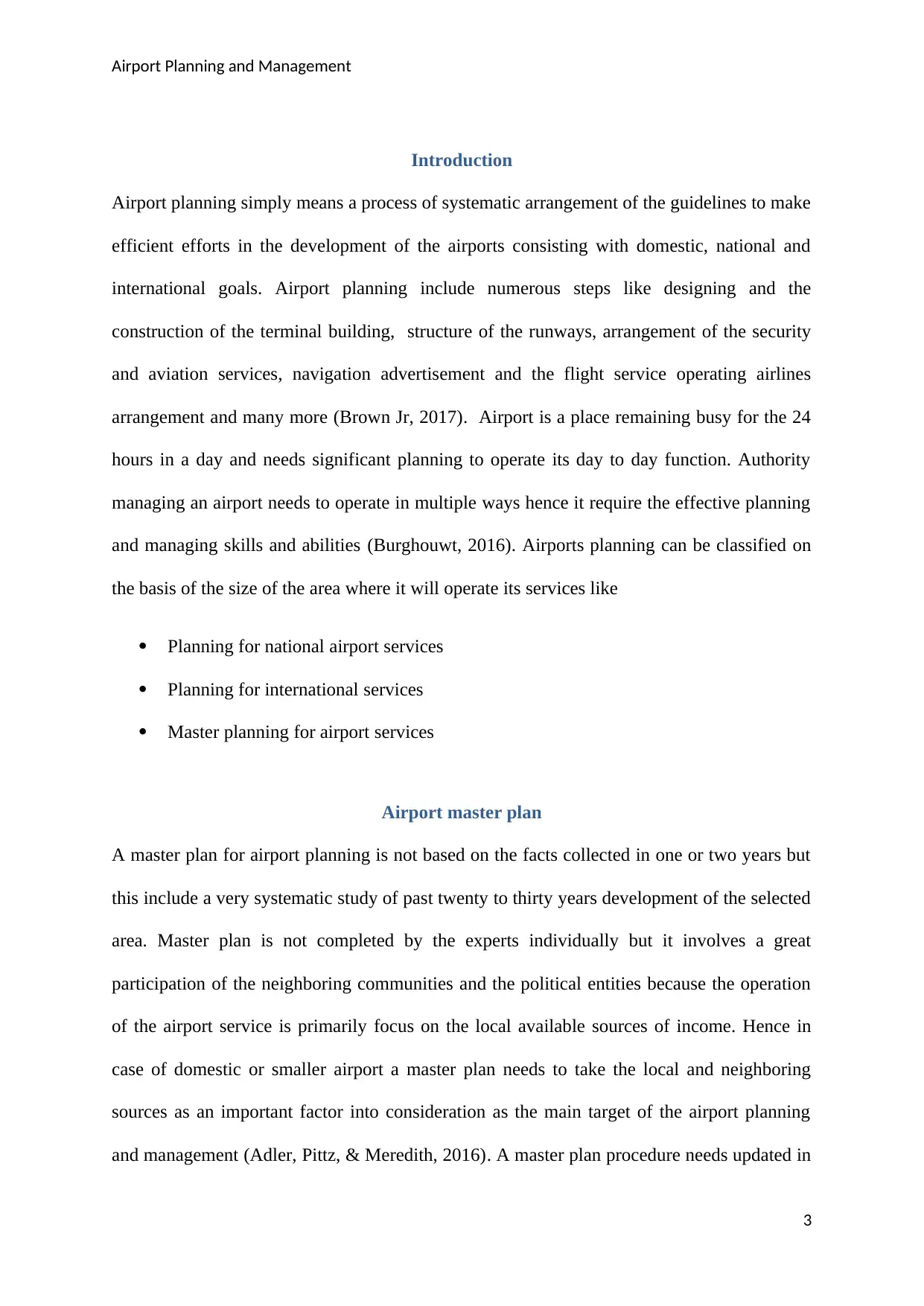
Airport Planning and Management
Introduction
Airport planning simply means a process of systematic arrangement of the guidelines to make
efficient efforts in the development of the airports consisting with domestic, national and
international goals. Airport planning include numerous steps like designing and the
construction of the terminal building, structure of the runways, arrangement of the security
and aviation services, navigation advertisement and the flight service operating airlines
arrangement and many more (Brown Jr, 2017). Airport is a place remaining busy for the 24
hours in a day and needs significant planning to operate its day to day function. Authority
managing an airport needs to operate in multiple ways hence it require the effective planning
and managing skills and abilities (Burghouwt, 2016). Airports planning can be classified on
the basis of the size of the area where it will operate its services like
Planning for national airport services
Planning for international services
Master planning for airport services
Airport master plan
A master plan for airport planning is not based on the facts collected in one or two years but
this include a very systematic study of past twenty to thirty years development of the selected
area. Master plan is not completed by the experts individually but it involves a great
participation of the neighboring communities and the political entities because the operation
of the airport service is primarily focus on the local available sources of income. Hence in
case of domestic or smaller airport a master plan needs to take the local and neighboring
sources as an important factor into consideration as the main target of the airport planning
and management (Adler, Pittz, & Meredith, 2016). A master plan procedure needs updated in
3
Introduction
Airport planning simply means a process of systematic arrangement of the guidelines to make
efficient efforts in the development of the airports consisting with domestic, national and
international goals. Airport planning include numerous steps like designing and the
construction of the terminal building, structure of the runways, arrangement of the security
and aviation services, navigation advertisement and the flight service operating airlines
arrangement and many more (Brown Jr, 2017). Airport is a place remaining busy for the 24
hours in a day and needs significant planning to operate its day to day function. Authority
managing an airport needs to operate in multiple ways hence it require the effective planning
and managing skills and abilities (Burghouwt, 2016). Airports planning can be classified on
the basis of the size of the area where it will operate its services like
Planning for national airport services
Planning for international services
Master planning for airport services
Airport master plan
A master plan for airport planning is not based on the facts collected in one or two years but
this include a very systematic study of past twenty to thirty years development of the selected
area. Master plan is not completed by the experts individually but it involves a great
participation of the neighboring communities and the political entities because the operation
of the airport service is primarily focus on the local available sources of income. Hence in
case of domestic or smaller airport a master plan needs to take the local and neighboring
sources as an important factor into consideration as the main target of the airport planning
and management (Adler, Pittz, & Meredith, 2016). A master plan procedure needs updated in
3
Paraphrase This Document
Need a fresh take? Get an instant paraphrase of this document with our AI Paraphraser
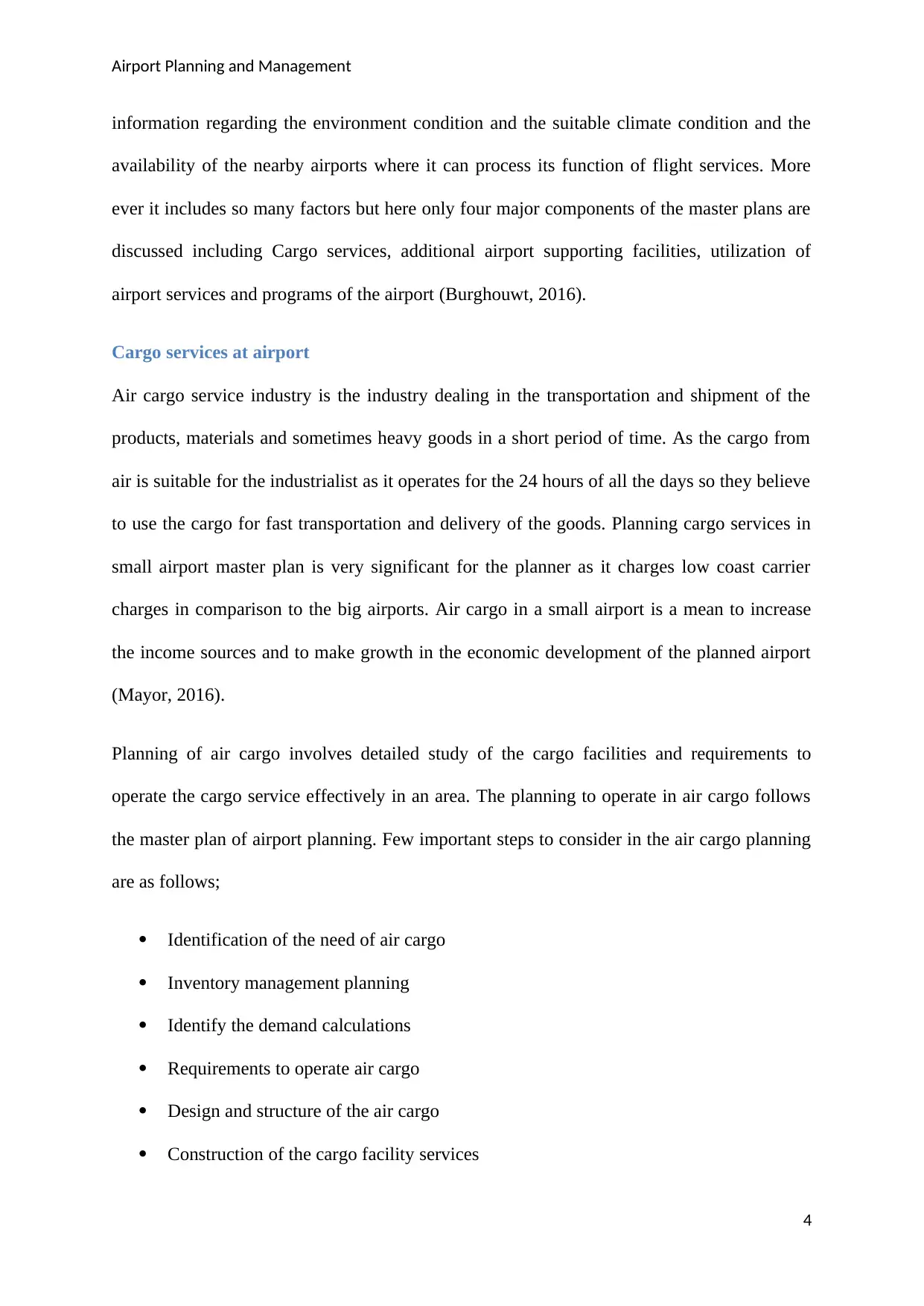
Airport Planning and Management
information regarding the environment condition and the suitable climate condition and the
availability of the nearby airports where it can process its function of flight services. More
ever it includes so many factors but here only four major components of the master plans are
discussed including Cargo services, additional airport supporting facilities, utilization of
airport services and programs of the airport (Burghouwt, 2016).
Cargo services at airport
Air cargo service industry is the industry dealing in the transportation and shipment of the
products, materials and sometimes heavy goods in a short period of time. As the cargo from
air is suitable for the industrialist as it operates for the 24 hours of all the days so they believe
to use the cargo for fast transportation and delivery of the goods. Planning cargo services in
small airport master plan is very significant for the planner as it charges low coast carrier
charges in comparison to the big airports. Air cargo in a small airport is a mean to increase
the income sources and to make growth in the economic development of the planned airport
(Mayor, 2016).
Planning of air cargo involves detailed study of the cargo facilities and requirements to
operate the cargo service effectively in an area. The planning to operate in air cargo follows
the master plan of airport planning. Few important steps to consider in the air cargo planning
are as follows;
Identification of the need of air cargo
Inventory management planning
Identify the demand calculations
Requirements to operate air cargo
Design and structure of the air cargo
Construction of the cargo facility services
4
information regarding the environment condition and the suitable climate condition and the
availability of the nearby airports where it can process its function of flight services. More
ever it includes so many factors but here only four major components of the master plans are
discussed including Cargo services, additional airport supporting facilities, utilization of
airport services and programs of the airport (Burghouwt, 2016).
Cargo services at airport
Air cargo service industry is the industry dealing in the transportation and shipment of the
products, materials and sometimes heavy goods in a short period of time. As the cargo from
air is suitable for the industrialist as it operates for the 24 hours of all the days so they believe
to use the cargo for fast transportation and delivery of the goods. Planning cargo services in
small airport master plan is very significant for the planner as it charges low coast carrier
charges in comparison to the big airports. Air cargo in a small airport is a mean to increase
the income sources and to make growth in the economic development of the planned airport
(Mayor, 2016).
Planning of air cargo involves detailed study of the cargo facilities and requirements to
operate the cargo service effectively in an area. The planning to operate in air cargo follows
the master plan of airport planning. Few important steps to consider in the air cargo planning
are as follows;
Identification of the need of air cargo
Inventory management planning
Identify the demand calculations
Requirements to operate air cargo
Design and structure of the air cargo
Construction of the cargo facility services
4
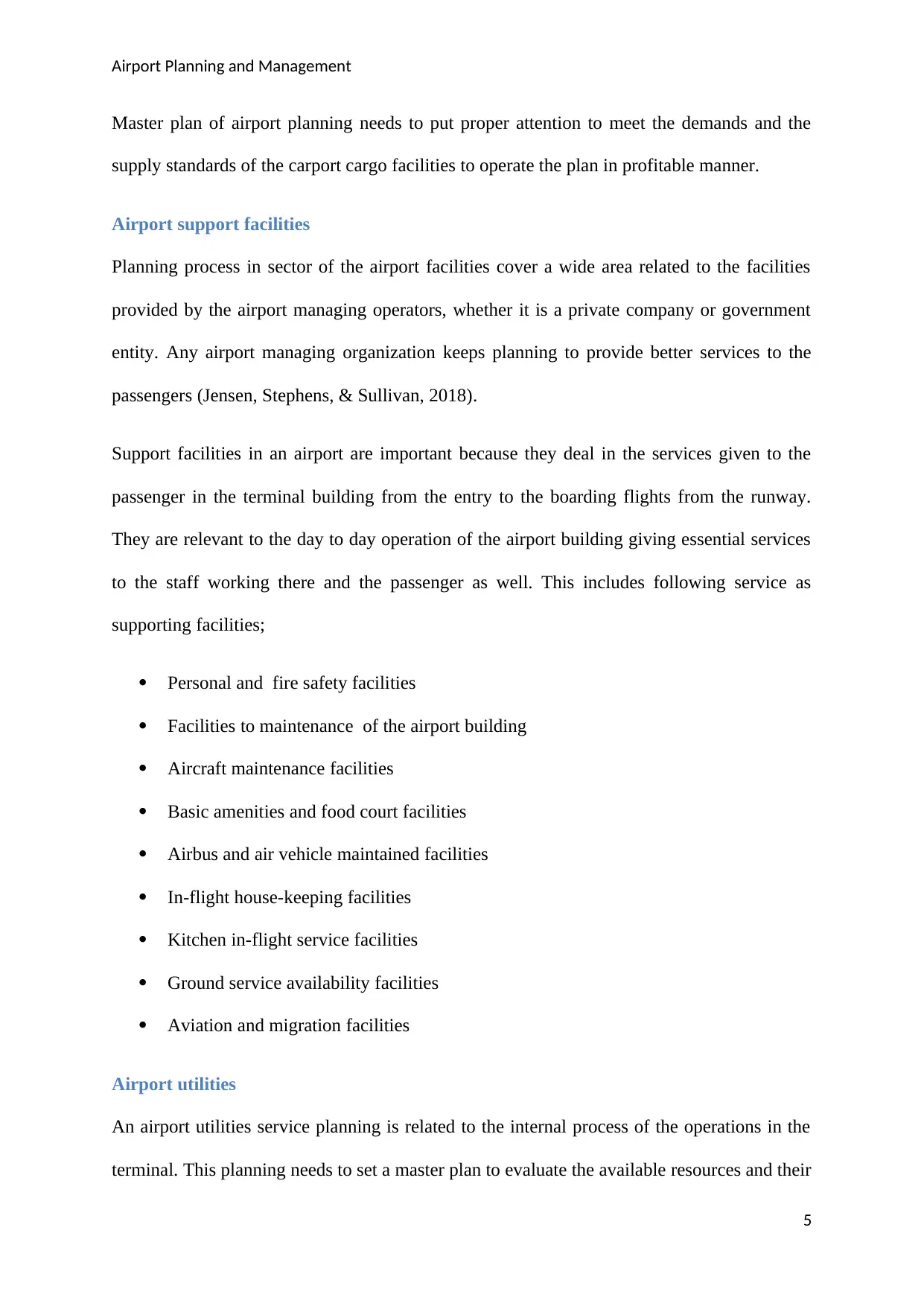
Airport Planning and Management
Master plan of airport planning needs to put proper attention to meet the demands and the
supply standards of the carport cargo facilities to operate the plan in profitable manner.
Airport support facilities
Planning process in sector of the airport facilities cover a wide area related to the facilities
provided by the airport managing operators, whether it is a private company or government
entity. Any airport managing organization keeps planning to provide better services to the
passengers (Jensen, Stephens, & Sullivan, 2018).
Support facilities in an airport are important because they deal in the services given to the
passenger in the terminal building from the entry to the boarding flights from the runway.
They are relevant to the day to day operation of the airport building giving essential services
to the staff working there and the passenger as well. This includes following service as
supporting facilities;
Personal and fire safety facilities
Facilities to maintenance of the airport building
Aircraft maintenance facilities
Basic amenities and food court facilities
Airbus and air vehicle maintained facilities
In-flight house-keeping facilities
Kitchen in-flight service facilities
Ground service availability facilities
Aviation and migration facilities
Airport utilities
An airport utilities service planning is related to the internal process of the operations in the
terminal. This planning needs to set a master plan to evaluate the available resources and their
5
Master plan of airport planning needs to put proper attention to meet the demands and the
supply standards of the carport cargo facilities to operate the plan in profitable manner.
Airport support facilities
Planning process in sector of the airport facilities cover a wide area related to the facilities
provided by the airport managing operators, whether it is a private company or government
entity. Any airport managing organization keeps planning to provide better services to the
passengers (Jensen, Stephens, & Sullivan, 2018).
Support facilities in an airport are important because they deal in the services given to the
passenger in the terminal building from the entry to the boarding flights from the runway.
They are relevant to the day to day operation of the airport building giving essential services
to the staff working there and the passenger as well. This includes following service as
supporting facilities;
Personal and fire safety facilities
Facilities to maintenance of the airport building
Aircraft maintenance facilities
Basic amenities and food court facilities
Airbus and air vehicle maintained facilities
In-flight house-keeping facilities
Kitchen in-flight service facilities
Ground service availability facilities
Aviation and migration facilities
Airport utilities
An airport utilities service planning is related to the internal process of the operations in the
terminal. This planning needs to set a master plan to evaluate the available resources and their
5
⊘ This is a preview!⊘
Do you want full access?
Subscribe today to unlock all pages.

Trusted by 1+ million students worldwide
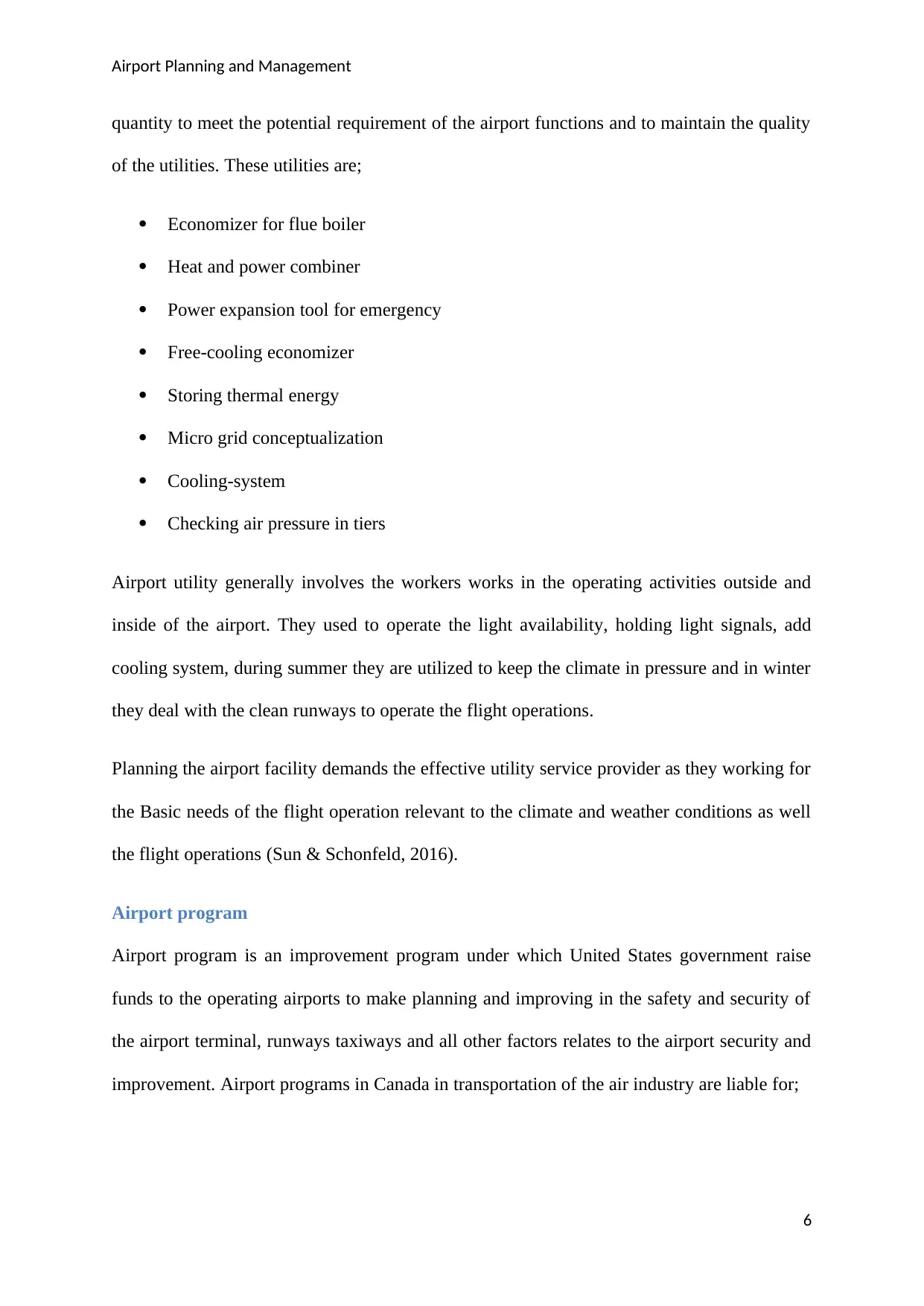
Airport Planning and Management
quantity to meet the potential requirement of the airport functions and to maintain the quality
of the utilities. These utilities are;
Economizer for flue boiler
Heat and power combiner
Power expansion tool for emergency
Free-cooling economizer
Storing thermal energy
Micro grid conceptualization
Cooling-system
Checking air pressure in tiers
Airport utility generally involves the workers works in the operating activities outside and
inside of the airport. They used to operate the light availability, holding light signals, add
cooling system, during summer they are utilized to keep the climate in pressure and in winter
they deal with the clean runways to operate the flight operations.
Planning the airport facility demands the effective utility service provider as they working for
the Basic needs of the flight operation relevant to the climate and weather conditions as well
the flight operations (Sun & Schonfeld, 2016).
Airport program
Airport program is an improvement program under which United States government raise
funds to the operating airports to make planning and improving in the safety and security of
the airport terminal, runways taxiways and all other factors relates to the airport security and
improvement. Airport programs in Canada in transportation of the air industry are liable for;
6
quantity to meet the potential requirement of the airport functions and to maintain the quality
of the utilities. These utilities are;
Economizer for flue boiler
Heat and power combiner
Power expansion tool for emergency
Free-cooling economizer
Storing thermal energy
Micro grid conceptualization
Cooling-system
Checking air pressure in tiers
Airport utility generally involves the workers works in the operating activities outside and
inside of the airport. They used to operate the light availability, holding light signals, add
cooling system, during summer they are utilized to keep the climate in pressure and in winter
they deal with the clean runways to operate the flight operations.
Planning the airport facility demands the effective utility service provider as they working for
the Basic needs of the flight operation relevant to the climate and weather conditions as well
the flight operations (Sun & Schonfeld, 2016).
Airport program
Airport program is an improvement program under which United States government raise
funds to the operating airports to make planning and improving in the safety and security of
the airport terminal, runways taxiways and all other factors relates to the airport security and
improvement. Airport programs in Canada in transportation of the air industry are liable for;
6
Paraphrase This Document
Need a fresh take? Get an instant paraphrase of this document with our AI Paraphraser
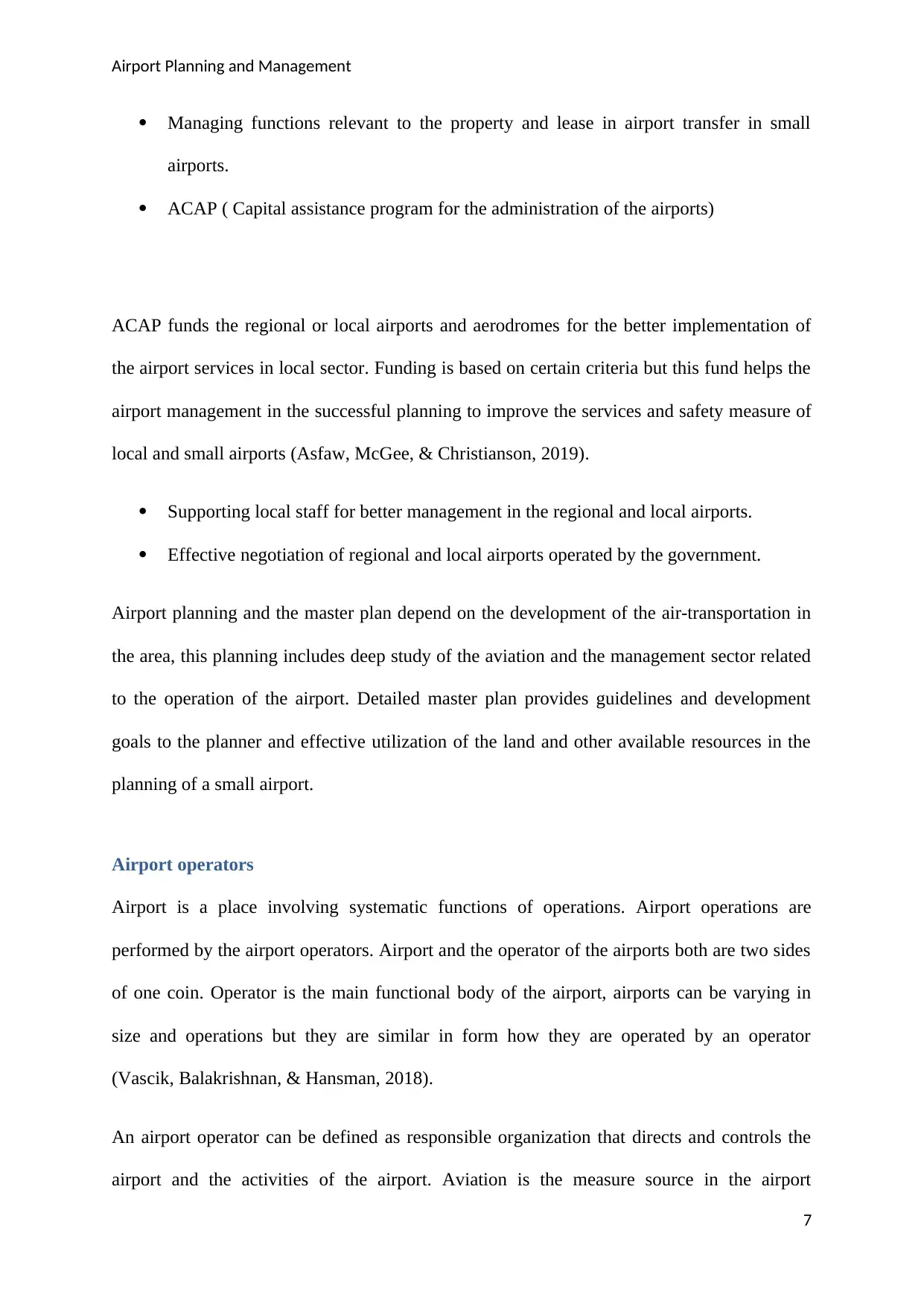
Airport Planning and Management
Managing functions relevant to the property and lease in airport transfer in small
airports.
ACAP ( Capital assistance program for the administration of the airports)
ACAP funds the regional or local airports and aerodromes for the better implementation of
the airport services in local sector. Funding is based on certain criteria but this fund helps the
airport management in the successful planning to improve the services and safety measure of
local and small airports (Asfaw, McGee, & Christianson, 2019).
Supporting local staff for better management in the regional and local airports.
Effective negotiation of regional and local airports operated by the government.
Airport planning and the master plan depend on the development of the air-transportation in
the area, this planning includes deep study of the aviation and the management sector related
to the operation of the airport. Detailed master plan provides guidelines and development
goals to the planner and effective utilization of the land and other available resources in the
planning of a small airport.
Airport operators
Airport is a place involving systematic functions of operations. Airport operations are
performed by the airport operators. Airport and the operator of the airports both are two sides
of one coin. Operator is the main functional body of the airport, airports can be varying in
size and operations but they are similar in form how they are operated by an operator
(Vascik, Balakrishnan, & Hansman, 2018).
An airport operator can be defined as responsible organization that directs and controls the
airport and the activities of the airport. Aviation is the measure source in the airport
7
Managing functions relevant to the property and lease in airport transfer in small
airports.
ACAP ( Capital assistance program for the administration of the airports)
ACAP funds the regional or local airports and aerodromes for the better implementation of
the airport services in local sector. Funding is based on certain criteria but this fund helps the
airport management in the successful planning to improve the services and safety measure of
local and small airports (Asfaw, McGee, & Christianson, 2019).
Supporting local staff for better management in the regional and local airports.
Effective negotiation of regional and local airports operated by the government.
Airport planning and the master plan depend on the development of the air-transportation in
the area, this planning includes deep study of the aviation and the management sector related
to the operation of the airport. Detailed master plan provides guidelines and development
goals to the planner and effective utilization of the land and other available resources in the
planning of a small airport.
Airport operators
Airport is a place involving systematic functions of operations. Airport operations are
performed by the airport operators. Airport and the operator of the airports both are two sides
of one coin. Operator is the main functional body of the airport, airports can be varying in
size and operations but they are similar in form how they are operated by an operator
(Vascik, Balakrishnan, & Hansman, 2018).
An airport operator can be defined as responsible organization that directs and controls the
airport and the activities of the airport. Aviation is the measure source in the airport
7
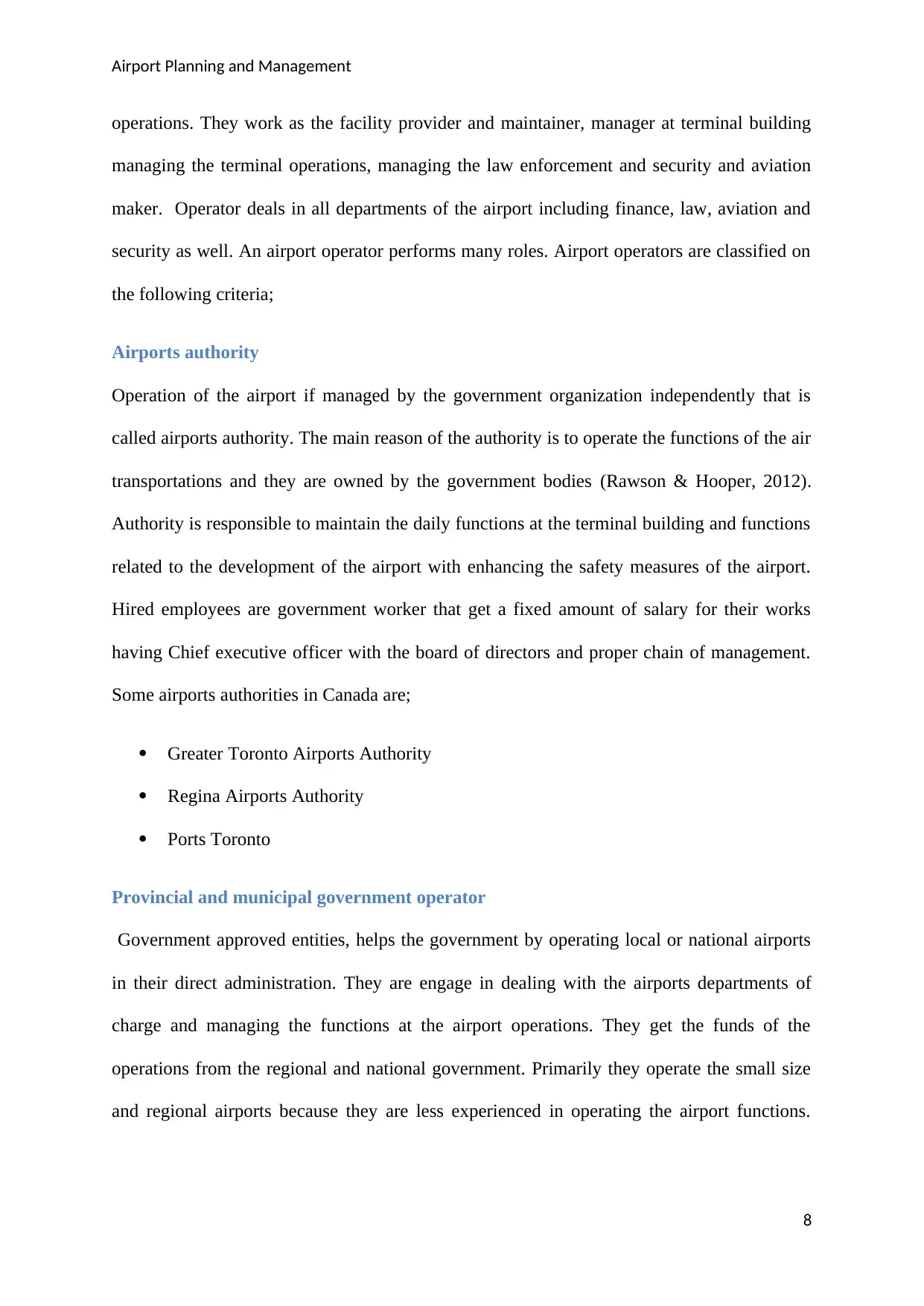
Airport Planning and Management
operations. They work as the facility provider and maintainer, manager at terminal building
managing the terminal operations, managing the law enforcement and security and aviation
maker. Operator deals in all departments of the airport including finance, law, aviation and
security as well. An airport operator performs many roles. Airport operators are classified on
the following criteria;
Airports authority
Operation of the airport if managed by the government organization independently that is
called airports authority. The main reason of the authority is to operate the functions of the air
transportations and they are owned by the government bodies (Rawson & Hooper, 2012).
Authority is responsible to maintain the daily functions at the terminal building and functions
related to the development of the airport with enhancing the safety measures of the airport.
Hired employees are government worker that get a fixed amount of salary for their works
having Chief executive officer with the board of directors and proper chain of management.
Some airports authorities in Canada are;
Greater Toronto Airports Authority
Regina Airports Authority
Ports Toronto
Provincial and municipal government operator
Government approved entities, helps the government by operating local or national airports
in their direct administration. They are engage in dealing with the airports departments of
charge and managing the functions at the airport operations. They get the funds of the
operations from the regional and national government. Primarily they operate the small size
and regional airports because they are less experienced in operating the airport functions.
8
operations. They work as the facility provider and maintainer, manager at terminal building
managing the terminal operations, managing the law enforcement and security and aviation
maker. Operator deals in all departments of the airport including finance, law, aviation and
security as well. An airport operator performs many roles. Airport operators are classified on
the following criteria;
Airports authority
Operation of the airport if managed by the government organization independently that is
called airports authority. The main reason of the authority is to operate the functions of the air
transportations and they are owned by the government bodies (Rawson & Hooper, 2012).
Authority is responsible to maintain the daily functions at the terminal building and functions
related to the development of the airport with enhancing the safety measures of the airport.
Hired employees are government worker that get a fixed amount of salary for their works
having Chief executive officer with the board of directors and proper chain of management.
Some airports authorities in Canada are;
Greater Toronto Airports Authority
Regina Airports Authority
Ports Toronto
Provincial and municipal government operator
Government approved entities, helps the government by operating local or national airports
in their direct administration. They are engage in dealing with the airports departments of
charge and managing the functions at the airport operations. They get the funds of the
operations from the regional and national government. Primarily they operate the small size
and regional airports because they are less experienced in operating the airport functions.
8
⊘ This is a preview!⊘
Do you want full access?
Subscribe today to unlock all pages.

Trusted by 1+ million students worldwide
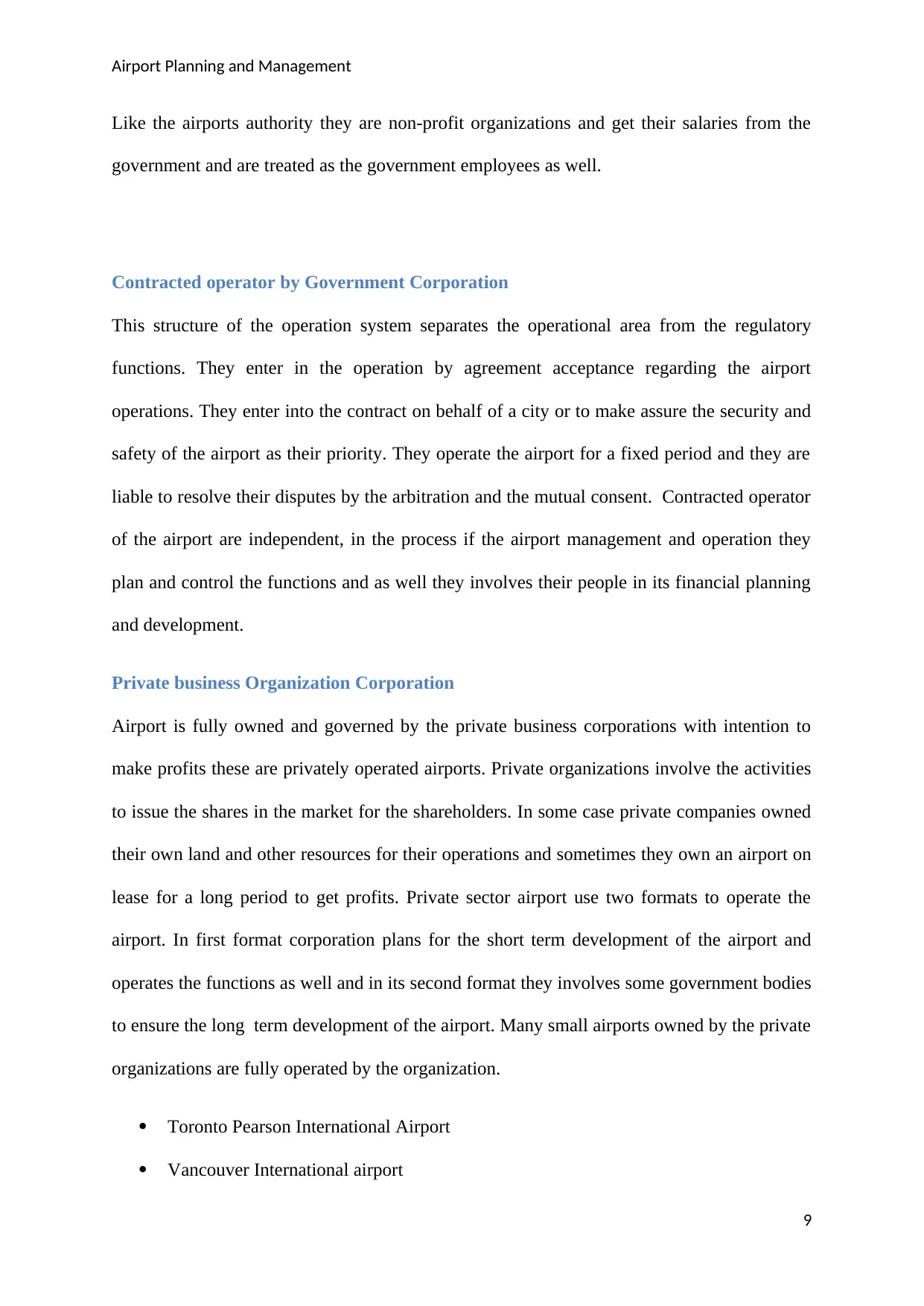
Airport Planning and Management
Like the airports authority they are non-profit organizations and get their salaries from the
government and are treated as the government employees as well.
Contracted operator by Government Corporation
This structure of the operation system separates the operational area from the regulatory
functions. They enter in the operation by agreement acceptance regarding the airport
operations. They enter into the contract on behalf of a city or to make assure the security and
safety of the airport as their priority. They operate the airport for a fixed period and they are
liable to resolve their disputes by the arbitration and the mutual consent. Contracted operator
of the airport are independent, in the process if the airport management and operation they
plan and control the functions and as well they involves their people in its financial planning
and development.
Private business Organization Corporation
Airport is fully owned and governed by the private business corporations with intention to
make profits these are privately operated airports. Private organizations involve the activities
to issue the shares in the market for the shareholders. In some case private companies owned
their own land and other resources for their operations and sometimes they own an airport on
lease for a long period to get profits. Private sector airport use two formats to operate the
airport. In first format corporation plans for the short term development of the airport and
operates the functions as well and in its second format they involves some government bodies
to ensure the long term development of the airport. Many small airports owned by the private
organizations are fully operated by the organization.
Toronto Pearson International Airport
Vancouver International airport
9
Like the airports authority they are non-profit organizations and get their salaries from the
government and are treated as the government employees as well.
Contracted operator by Government Corporation
This structure of the operation system separates the operational area from the regulatory
functions. They enter in the operation by agreement acceptance regarding the airport
operations. They enter into the contract on behalf of a city or to make assure the security and
safety of the airport as their priority. They operate the airport for a fixed period and they are
liable to resolve their disputes by the arbitration and the mutual consent. Contracted operator
of the airport are independent, in the process if the airport management and operation they
plan and control the functions and as well they involves their people in its financial planning
and development.
Private business Organization Corporation
Airport is fully owned and governed by the private business corporations with intention to
make profits these are privately operated airports. Private organizations involve the activities
to issue the shares in the market for the shareholders. In some case private companies owned
their own land and other resources for their operations and sometimes they own an airport on
lease for a long period to get profits. Private sector airport use two formats to operate the
airport. In first format corporation plans for the short term development of the airport and
operates the functions as well and in its second format they involves some government bodies
to ensure the long term development of the airport. Many small airports owned by the private
organizations are fully operated by the organization.
Toronto Pearson International Airport
Vancouver International airport
9
Paraphrase This Document
Need a fresh take? Get an instant paraphrase of this document with our AI Paraphraser
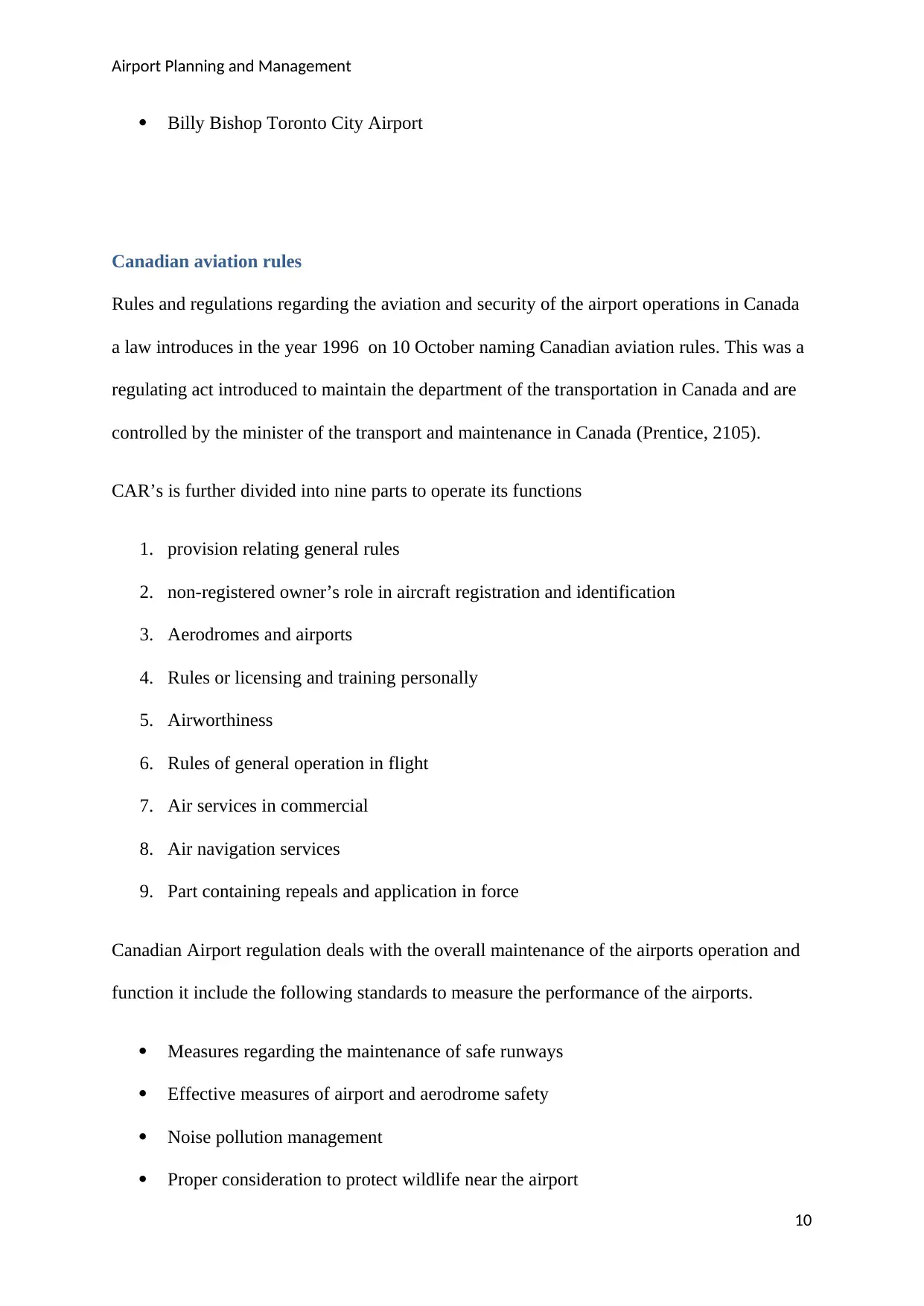
Airport Planning and Management
Billy Bishop Toronto City Airport
Canadian aviation rules
Rules and regulations regarding the aviation and security of the airport operations in Canada
a law introduces in the year 1996 on 10 October naming Canadian aviation rules. This was a
regulating act introduced to maintain the department of the transportation in Canada and are
controlled by the minister of the transport and maintenance in Canada (Prentice, 2105).
CAR’s is further divided into nine parts to operate its functions
1. provision relating general rules
2. non-registered owner’s role in aircraft registration and identification
3. Aerodromes and airports
4. Rules or licensing and training personally
5. Airworthiness
6. Rules of general operation in flight
7. Air services in commercial
8. Air navigation services
9. Part containing repeals and application in force
Canadian Airport regulation deals with the overall maintenance of the airports operation and
function it include the following standards to measure the performance of the airports.
Measures regarding the maintenance of safe runways
Effective measures of airport and aerodrome safety
Noise pollution management
Proper consideration to protect wildlife near the airport
10
Billy Bishop Toronto City Airport
Canadian aviation rules
Rules and regulations regarding the aviation and security of the airport operations in Canada
a law introduces in the year 1996 on 10 October naming Canadian aviation rules. This was a
regulating act introduced to maintain the department of the transportation in Canada and are
controlled by the minister of the transport and maintenance in Canada (Prentice, 2105).
CAR’s is further divided into nine parts to operate its functions
1. provision relating general rules
2. non-registered owner’s role in aircraft registration and identification
3. Aerodromes and airports
4. Rules or licensing and training personally
5. Airworthiness
6. Rules of general operation in flight
7. Air services in commercial
8. Air navigation services
9. Part containing repeals and application in force
Canadian Airport regulation deals with the overall maintenance of the airports operation and
function it include the following standards to measure the performance of the airports.
Measures regarding the maintenance of safe runways
Effective measures of airport and aerodrome safety
Noise pollution management
Proper consideration to protect wildlife near the airport
10
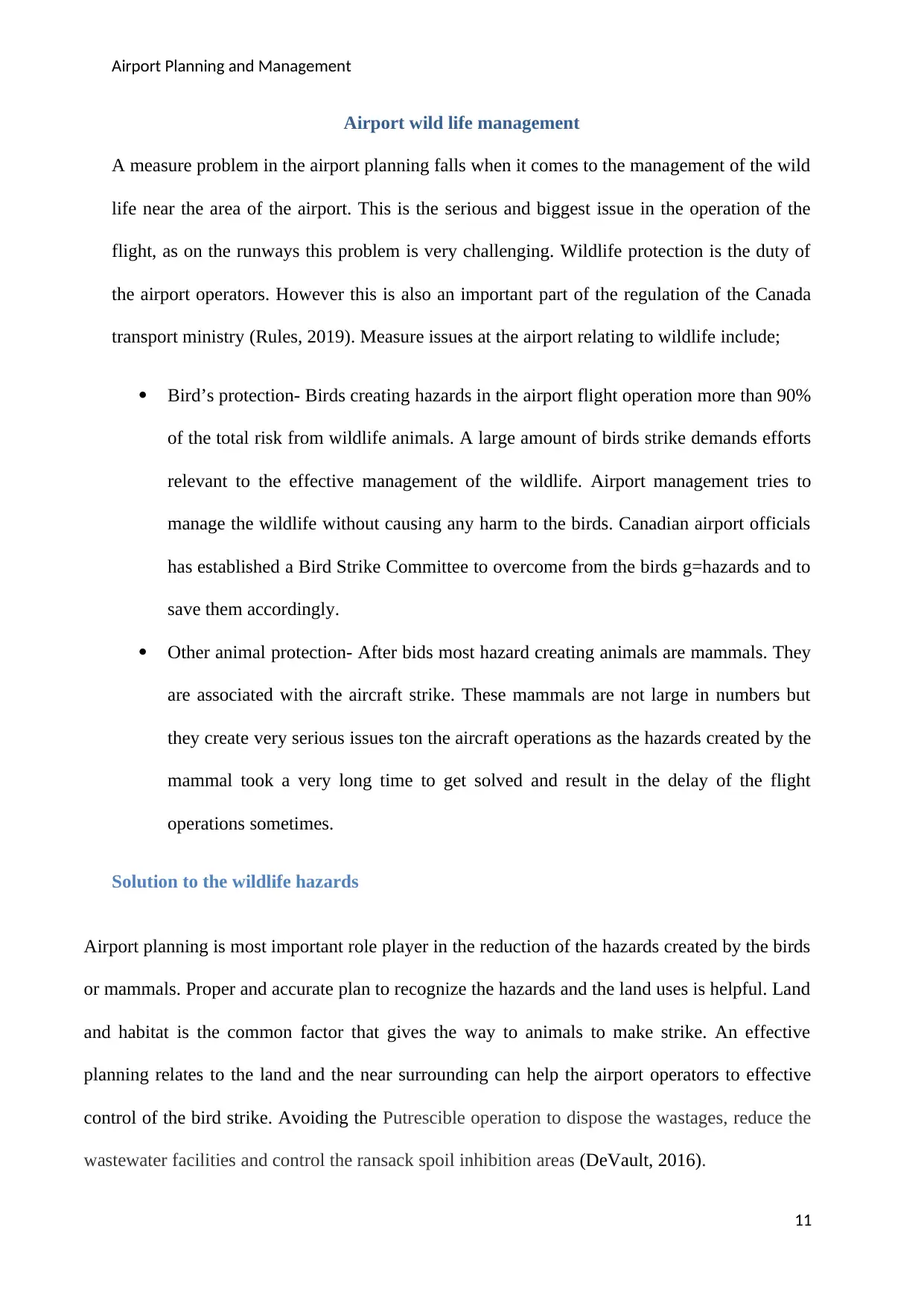
Airport Planning and Management
Airport wild life management
A measure problem in the airport planning falls when it comes to the management of the wild
life near the area of the airport. This is the serious and biggest issue in the operation of the
flight, as on the runways this problem is very challenging. Wildlife protection is the duty of
the airport operators. However this is also an important part of the regulation of the Canada
transport ministry (Rules, 2019). Measure issues at the airport relating to wildlife include;
Bird’s protection- Birds creating hazards in the airport flight operation more than 90%
of the total risk from wildlife animals. A large amount of birds strike demands efforts
relevant to the effective management of the wildlife. Airport management tries to
manage the wildlife without causing any harm to the birds. Canadian airport officials
has established a Bird Strike Committee to overcome from the birds g=hazards and to
save them accordingly.
Other animal protection- After bids most hazard creating animals are mammals. They
are associated with the aircraft strike. These mammals are not large in numbers but
they create very serious issues ton the aircraft operations as the hazards created by the
mammal took a very long time to get solved and result in the delay of the flight
operations sometimes.
Solution to the wildlife hazards
Airport planning is most important role player in the reduction of the hazards created by the birds
or mammals. Proper and accurate plan to recognize the hazards and the land uses is helpful. Land
and habitat is the common factor that gives the way to animals to make strike. An effective
planning relates to the land and the near surrounding can help the airport operators to effective
control of the bird strike. Avoiding the Putrescible operation to dispose the wastages, reduce the
wastewater facilities and control the ransack spoil inhibition areas (DeVault, 2016).
11
Airport wild life management
A measure problem in the airport planning falls when it comes to the management of the wild
life near the area of the airport. This is the serious and biggest issue in the operation of the
flight, as on the runways this problem is very challenging. Wildlife protection is the duty of
the airport operators. However this is also an important part of the regulation of the Canada
transport ministry (Rules, 2019). Measure issues at the airport relating to wildlife include;
Bird’s protection- Birds creating hazards in the airport flight operation more than 90%
of the total risk from wildlife animals. A large amount of birds strike demands efforts
relevant to the effective management of the wildlife. Airport management tries to
manage the wildlife without causing any harm to the birds. Canadian airport officials
has established a Bird Strike Committee to overcome from the birds g=hazards and to
save them accordingly.
Other animal protection- After bids most hazard creating animals are mammals. They
are associated with the aircraft strike. These mammals are not large in numbers but
they create very serious issues ton the aircraft operations as the hazards created by the
mammal took a very long time to get solved and result in the delay of the flight
operations sometimes.
Solution to the wildlife hazards
Airport planning is most important role player in the reduction of the hazards created by the birds
or mammals. Proper and accurate plan to recognize the hazards and the land uses is helpful. Land
and habitat is the common factor that gives the way to animals to make strike. An effective
planning relates to the land and the near surrounding can help the airport operators to effective
control of the bird strike. Avoiding the Putrescible operation to dispose the wastages, reduce the
wastewater facilities and control the ransack spoil inhibition areas (DeVault, 2016).
11
⊘ This is a preview!⊘
Do you want full access?
Subscribe today to unlock all pages.

Trusted by 1+ million students worldwide
1 out of 18
Related Documents
Your All-in-One AI-Powered Toolkit for Academic Success.
+13062052269
info@desklib.com
Available 24*7 on WhatsApp / Email
![[object Object]](/_next/static/media/star-bottom.7253800d.svg)
Unlock your academic potential
Copyright © 2020–2025 A2Z Services. All Rights Reserved. Developed and managed by ZUCOL.



